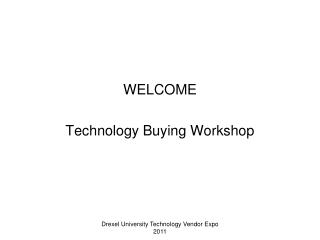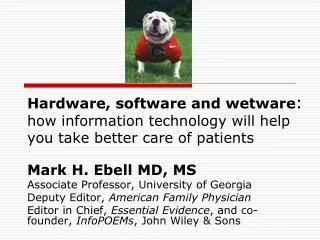Hardware & Software
General concepts of ICT systems. Hardware & Software. Objectives. Know what is meant by the terms ‘hardware’ and ‘software’ Understand the difference between systems software and applications software Be able to define hardware , giving examples; define software , giving examples;
Share Presentation
Embed Code
Link
Download Presentation
- physical body what
- sound file
- utility programs
- central processing unit
- computer system
- backing

royce + Follow
Download Presentation
Hardware & Software
An Image/Link below is provided (as is) to download presentation Download Policy: Content on the Website is provided to you AS IS for your information and personal use and may not be sold / licensed / shared on other websites without getting consent from its author. Content is provided to you AS IS for your information and personal use only. Download presentation by click this link. While downloading, if for some reason you are not able to download a presentation, the publisher may have deleted the file from their server. During download, if you can't get a presentation, the file might be deleted by the publisher.
Presentation Transcript
- General concepts of ICT systems Hardware & Software
- Objectives • Know what is meant by the terms ‘hardware’ and ‘software’ • Understand the difference between systems software and applications software • Be able to • define hardware, giving examples; • define software, giving examples; • describe the difference between hardware and software
- What is hardware? • Hardware is the physical parts of the computer system – the parts that you can touch and see. • A motherboard, a CPU, a keyboard and a monitor are all items of hardware.
- An analogy… • Your hardware is all of the parts that make up your body: bones, muscles, skin, blood, etc.
- Examples of external hardware • We will look at each of these in more detail in a future lesson. • Other examples include: • Scanner • Web cam • Camera • Fan
- Examples of internal hardware • We will look at each of these in more detail in a future lesson. • Other examples include: • Graphics card • IDE ribbon • Power supply • Fan
- Peripherals • A peripheral is any hardware device which connects to the computer and is controlled by the Central Processing Unit (CPU) -with the exception of memory. • When you are trying to think of examples of peripherals, think of things which plug into the back of the box. • Examples are: • monitor • keyboard • mouse • printer • scanner • speakers • external hard drives
- What is Software? • Software is a collection of instructions that can be ‘run’ on a computer. These instructions tell the computer what to do.
- What is software? • To continue the analogy…Your software is all of your thoughts and mental processes: these are the instructions that tell your physical body what to do
- What is software? • Software is not a physical thing (but it can of course be stored on a physical medium such as a CD-ROM), it is just a bunch of codes. • An operating system such as Windows XP or Mac OS X, applications such as Microsoft Word, and the instructions that control a robot are all examples of software.
- The Difference Between Hardware and Software • Computer hardware is the physical components that make up the computer system. Hardware is useless without software to run on it. • Software is instructions that tell computer hardware what to do. Software is useless unless there is hardware to run it on. • For a computer system to be useful it has to consist of both hardware and software. +
- Completing the analogy: • Your physical body cannot function without your thoughts - and your thoughts need a physical body to exist within
- Systems software • There are two main types of software which you will learn about in detail later on. • The first is 'systems software' which basically controls the way the computer works and tells it what to do. Examples include: • Operating System • Utilities • User Interface
- Applications software • The other type of software is called ‘applications software' and it is this type of software that you use to do your work and have fun. Some examples include: • Word processors such as Microsoft Word • Spreadsheets such as Microsoft Excel • Databases such as Microsoft Access • Games applications such as Half Life, Call of Duty etc
- Utility programs • A Utility program is designed to do one or perhaps two tasks very well and nothing else. • For example, you may want to compress a file to let you save it on to a floppy disk. For this task you would choose to use a file compression utility program.
- Quite often, a Utility program is built right in to the operating system. For example Windows XP has a built in 'Zip' compression utility you can use to compress a file or folder.
- Other utility programs • File management • Backup management • Disk Defragmenter
- Types of utility programs Here are some very common tasks that are carried out by various Utility programs: • File sorting • File renaming • File conversion (e.g. convert a sound file to MP3) • File repair • Disk monitoring and defragmentation (defragging) • Printing jobs • Backing up data. • Anti-Virus • Note that a utility program only does one or perhaps two of these.
- Drivers • A driver is another essential piece of system software • A driver is a specially written program which translates the commands from the operating system into commands that a piece of hardware (eg a printer) will understand.
- Each piece of hardware e.g. printer, monitor, scanner, keyboard etc will have its own driver. • Printers from different manufacturers work in different ways, so a printer from Samsung will need a different driver than a printer from HP, Canon or Dell.
- Drivers • If you try to use a device without the correct driver, then it probably won’t work. If you do manage to get your new printer working without installing its driver, it will probably just print rubbish! • This is what comes out of a printer with the correct driver installed: This is a printout • This is what comes out of the printer with the incorrect driver installed: Jajshufuau&(( 89asd 8fa8s9d
- When you buy a new piece of hardware, it will usually come with an installation disk which will load the new drivers into the operating system. Very often, you can also download the drivers from the internet.
- Homework: Wiki page/ICT Basics Hardware & Software: 2 x Read, Activity, Test MAKE NOTES IN YOUR BOOKS!

Hardware and Software Acquisition
Hardware and Software Acquisition Hardware and Software Acquisition L.B. Brady Information Technology Services l.brady@its.utexas.edu Trina Bickford Purchasing Office tbickford@austin.utexas.edu Objective
1.46k views • 24 slides

Chapter 1
Chapter 1. Introducing Hardware. You Will Learn…. That a computer requires both hardware and software to work About the many different hardware components inside and connected to a computer. Hardware Needs Software to Work. Hardware Physical components of a computer
862 views • 52 slides

Chapter 3 HCS12 Members and Hardware and Software Development Tools
Chapter 3 HCS12 Members and Hardware and Software Development Tools. The HCS12 Members (1 of 2). Is a redesign of the 68HC12 family The 68HC12 family is an upgrade of the popular 68HC11 8-bit microcontroller family. The 68HC12 has a highest bus clock frequency of 8 MHz.
1.24k views • 65 slides

WELCOME Technology Buying Workshop
WELCOME Technology Buying Workshop . Computer Hardware. Computer Marketplace: http://www.drexel.edu/irt/DownloadsAndComputers IRT's one stop link for computer hardware and software Contains computer specs, buyers guide, approved vendors, educational pricing, faculty upgrades, etc.
1.12k views • 79 slides

VHDL and Sequential circuit Synthesis
VHDL and Sequential circuit Synthesis. VHDL constructs versus automatic synthesis What is synthesis? Building blocks Issues and example Tools and targets. Hardware Description Language (HDL). Describe hardware – not software Description – structure
1.85k views • 129 slides

Introductions to Sensor Network Hardware
Introductions to Sensor Network Hardware. Outline. Platforms and microcontrollers Software Electronics, schematics and datasheets. WSN Platform. A hardware device that enable wireless sensor network research Typical components Microcontroller Radio Power supply
1.68k views • 94 slides

Hardware, software and wetware : how information technology will help you take better care of patients
Hardware, software and wetware : how information technology will help you take better care of patients. Mark H. Ebell MD, MS Associate Professor, University of Georgia Deputy Editor, American Family Physician
1k views • 63 slides

Computer Organization & Design The Hardware/Software Interface, 2nd Edition Patterson & Hennessy Lectures Inst
Computer Organization & Design The Hardware/Software Interface, 2nd Edition Patterson & Hennessy Lectures Instructor: Chen, Chang-jiu. 1.Computer Abstractions and Technology 002 – 050(049) 2.The Role of Performance 052 – 102(051) 3.Instructions: Language of the Machine 104 – 206(103)
2.41k views • 118 slides

Software Design
Software Design. Topics in Architectural Design . Material drawn from [Shaw96, Perry93]. Software Architecture Topics. Terminology and Motivation Intuition About Architecture: Hardware Network Building Architecture. Software Architecture Topics.
1.63k views • 98 slides

Chapter 2
Chapter 2. How an OS Works with Hardware and Other Software. You Will Learn…. About the hardware components of a PC How an OS relates to hardware and software About the system resources that hardware and software use for communication. Introducing Hardware. Ports Used by External Devices
1.09k views • 65 slides

Instruction Set Architecture & Pipelining
Instruction Set Architecture & Pipelining. CS 505: Computer Architecture Spring 2005 Thu D. Nguyen. Instruction Set Architecture (ISA). software. instruction set. hardware. instruction set. hardware. Instruction Set Architecture (ISA). software. Higher-Level Languages. compiler.
1.51k views • 98 slides

Developing Efficient Graphics Software
Developing Efficient Graphics Software. Developing Efficient Graphics Software. Intent of Course Identify application and hardware interaction Quantify and optimize interaction Identify efficient software structure Balance software and hardware system component use.
1.75k views • 159 slides

CHAPTER 5
CHAPTER 5. IT ARCHITECTURES Presented by Bernt Karlsson. Chapter Five Overview. SECTION 5.1 - HARDWARE AND SOFTWARE BASICS Hardware Basics Computer Categories Software Basics SECTION 5.2 – MANAGING ENTERPRISE ARCHITECTURES Enterprise Architectures Information Architecture
883 views • 74 slides

GIS Software
GIS Software. GIS Software. The evolution of GIS software Architecture of GIS software GIS software components GIS software functions Types of GIS software Usage of GIS software. The evolution of GIS software. Early days: a collection of computer programs
1.8k views • 29 slides

Session - 1 Basics Of Computers
Session - 1 Basics Of Computers. VIVEK KUMAR SINGH vivek@bhu.ac.in. A Desktop Machine. A Computer System. Hardware Software User. User. Software. Hardware. A Computer System (Contd.).
1.05k views • 84 slides

AVIONICS SYSTEMS AND SOFTWARE Part 2
AVIONICS SYSTEMS AND SOFTWARE Part 2. AVIONICS SYSTEMS AND SOFTWARE Real time considerations in Avionics System / Software design Software functional architecture ( mission computer/flight mgmt computer ) Scheduling General Avionics computer features(hardware)
1.08k views • 52 slides

HOSPICARE
Presents. HOSPICARE. A Total Hospital Management Software (THMS). Executive Summary. TSL is Multi Entrepreneur Promoted Company The Company is into Four Verticals: -- Software Product/ Solution Customised Solution Hardware Services
1.39k views • 118 slides



















